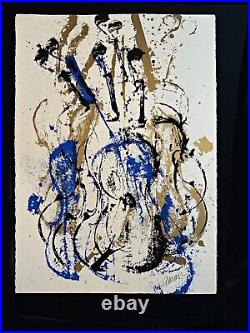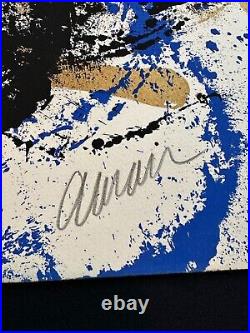


Of the world’s finest artists from. Our collection to yours. Thank you for visiting.. Color lithograph on Arches paper. Signed in pencil by the artist lower right. Excellent Numbered from 150, lower left. 23 1/2 x 30 Inches. Arman was a French-born American artist. Born Armand Fernandez in Nice, France, Arman was a painter who moved from using objects for the ink or paint traces they leave (cachets, allures d’objet) to using them as the artworks themselves. He is best known for his Accumulations and destruction/recomposition of objects. Arman’s father, Antonio Fernandez, an antiques dealer from Nice, was also an amateur artist, photographer, and cellist. From his father, Arman learned oil painting and photography. After receiving his bachelor’s degree in philosophy and mathematics in 1946, Arman began studying at the École Nationale des Arts Décoratifs in Nice. He also studied judo at a police school in Nice, where he met Yves Klein and Claude Pascal. The trio bonded closely on a subsequent hitch-hiking tour around Europe. Completing his studies in 1949, Arman enrolled as a student at the École du Louvre in Paris, where he concentrated on the study of archaeology and Asian art. In 1951, he became a teacher at the Bushido Kai Judo Club in Madrid, Spain. During this time he also served in the French military, completing his tour of duty as a medical orderly during the Indo-China War. Early on, it was apparent that Arman’s concept of the accumulation of vast quantities of similar objects was to remain a significant component of his art. He had originally focused more attention on his abstract paintings, considering them to be of more consequence than his early accumulations of rubber stamps. Only when he witnessed viewer reaction to his first Accumulation in 1959 did he fully recognize the power of such art. In 1962, he began welding together Accumulations of similar kinds of metal objects, such as axes. Inspired by an exhibition for the German Dadaist Kurt Schwitters in 1954, Arman began working on Cachets, his first major artistic undertaking. At his third solo exhibition held in Paris’s Galerie Iris Clert in 1958, Arman showed some of his first 2D accumulations he called Cachets. These rubber stamp marks on paper and fabric proved a success and provided an important change of course for the young artist’s career. At the time, he was signing only with his first name as an homage to Van Gogh, who also signed his works with his first name, “Vincent”. In 1957, Arman chose to change his name from “Armand” to “Arman”. On January 31, 1973, upon becoming a citizen of the United States, he took the American civil name, “Armand Pierre Arman”. Nevertheless, he continued to use “Arman” as his public persona. From 1959 to 1962, Arman developed his most recognizable style, beginning with his two most renowned concepts: Accumulations and Poubelles (French for “trash bins”). Accumulations were collections of commonplace and similar objects which he arranged within transparent polyester castings, or within Plexiglas cases. His first welded Accumulations were created in 1962. The Poubelles were collections of strewn refuse. In 1960, he filled the Iris Clert Gallery in Paris with trash, creating Le Plein (The Full) as a counterpoint to an exhibition called Le Vide (The Void) at the same gallery two years earlier by his friend Yves Klein. In October 1960, Arman, Yves Klein, François Dufrêne, Raymond Hains, Martial Raysse, Daniel Spoerri, Jean Tinguely, Jacques Villeglé, and art critic and philosopher Pierre Restany founded the Nouveau Réalisme group. Joined later by Cesar, Mimmo Rotella, Niki de Saint Phalle, and Christo, the group of young artists defined themselves as bearing in common their “new perspective approaches of reality”. They were reassessing the concept of art and the artist for a 20th-century consumer society by reasserting humanistic ideals in the face of industrial expansion. Arman also became affiliated with the ZERO art movement based in Germany. In 1961, Arman made his debut in the United States, the country which was to become his second home. During this period, he explored creation via destruction. The Coupes (Cuts) and the Colères (Angers) featured sliced, burned, or smashed objects arranged on canvas, often using objects with a strong “identity” such as musical instruments (mainly violins and saxophones) or bronze statues. Arman can be seen in Andy Warhol’s film Dinner at Daley’s, a documentation of a dinner performance by the Fluxus artist Daniel Spoerri that Warhol filmed on March 5, 1964. Throughout the portrait-screen-test film, Arman sits in profile, looking down, appearing to be entranced in his reading, seemingly unaware of Warhol’s camera, only making small gestures, rubbing his eyes, and licking the corner of his mouth. He remained silent, eyes gazing over the pages of what seemed to be a newspaper, in this four-minute, 16mm black-and-white reel. Fascinated with the scene in New York City, Arman took up part-time residency there from his home in Nice in 1961, after his first exhibition at the Cordier Warren Gallery. In the city, he met Marcel Duchamp at a dinner given by the artist and collector William Copley. First living at the Chelsea Hotel and later in Church street, while keeping a studio in Bowery, then in TriBeCa, Arman began work on large public sculptures. There were varied expressions of the Accumulations, including tools, watches, clocks, furniture, automobile parts, jewelry, and musical instruments in various stages of dismemberment. Musical instruments, specifically the strings and bronze, through his collaboration with a foundry in Normandy, France, became a major theme in Arman’s work. Of Arman’s Accumulations, one of the largest is Long Term Parking, which is on permanent display at the Château de Montcel in Jouy-en-Josas, France. Completed in 1982, this 60-foot (18 m) high sculpture consists of 60 mostly French cars set in 40,000 pounds (18,000 kg) of concrete. Just as ambitious was his 1995 work Hope for Peace, [8] which was specially commissioned by the Lebanese government to commemorate 50 years of their military’s service. Standing in once war-torn Beirut, the 32-metre (105 ft) monument consists of 83 tanks and military vehicles. In 1971, he married Corice Canton, with whom he had one daughter, Yasmine (1982) and one son, Philippe (1987). In 1989, he had his sixth and last child, Yves Cesar Arman, son of Carrole Cesar. After Arman’s death in New York in 2005, some of his ashes were buried at the Père Lachaise Cemetery in Paris in 2008. Accompanied by a Certificate of Authenticity and is Fully Guaranteed to be Certified as Described. Any framing included in a listing is double matted and framed in a solid wood moulding. We can also frame any pieces not listed as such. We are usually half the price of a regular framer. We guarantee all our listings to be 100% as described.

